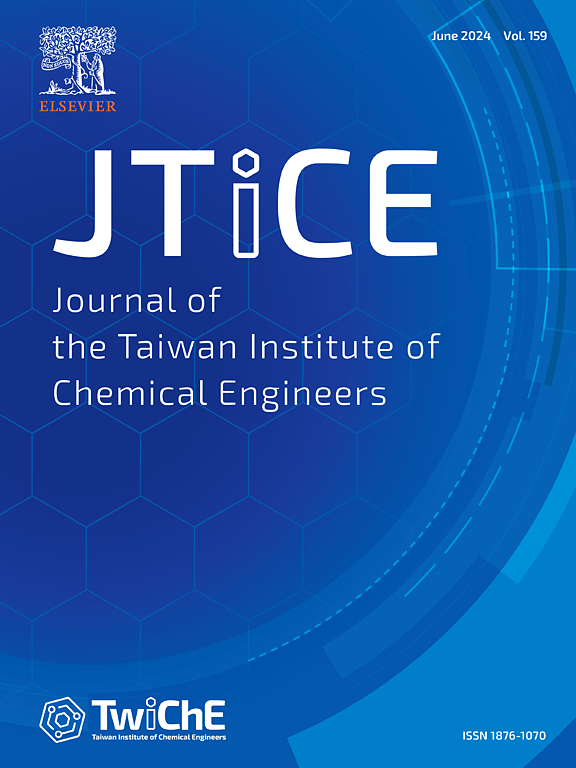通过动态逐层组装,坚固的中空纤维纳滤膜具有高稳定性,可用于废水处理
IF 5.5
3区 工程技术
Q1 ENGINEERING, CHEMICAL
Journal of the Taiwan Institute of Chemical Engineers
Pub Date : 2025-04-19
DOI:10.1016/j.jtice.2025.106146
引用次数: 0
摘要
纳滤膜在废水处理中的稳定性是制约其发展的主要因素。在这项工作中,通过在聚醚砜(PES)中空纤维超滤膜的内表面动态逐层(LBL)组装聚(4-苯磺酸钠)(PSS)和聚(二烯丙基二甲基氯化铵)(PDDA),制备了具有强大稳定性的中空纤维纳滤膜。评估了不同涂层对膜性能的影响,结果表明,最佳涂层为 2 的 LBL 膜的纯水渗透率为 9.59 L m-2 h-1 bar-1,对 Na2SO4 和 MgSO4 的截留率分别为 92.11 % 和 87.28 %。即使在不同的 pH 值和反冲洗条件下进行了四次防污测试,也能获得稳定的纯水渗透率。在实际的废水处理中,膜仍能保持稳定的渗透率,对废水中 Ca2+、Mg2+ 和 SO42- 离子的去除率分别为 81.25%、87.81% 和 76.79%,对总有机碳的去除率高达 92.90%。总之,所开发的膜具有经济效益,在工业生产和实际废水处理程序中具有巨大的应用潜力。本文章由计算机程序翻译,如有差异,请以英文原文为准。

Robust hollow fiber nanofiltration membranes with high stability for wastewater process by dynamic layer-by-layer assembly
The stability of nanofiltration membranes in wastewater treatment represents a primary constraint to their development. In this work, hollow fiber nanofiltration membranes with robust stability were prepared by dynamic layer-by-layer (LBL) assembly of poly (sodium 4-benzenesulfonate) (PSS) and poly (diallyldimethyl ammonium chloride) (PDDA) on the internal surface of poly (ether sulfone) (PES) hollow fiber ultrafiltration membranes. The effect of different coating layers on the membrane performance was assessed, and the findings revealed that the LBL membrane with the optimal coating layer of 2 had a pure water permeance of 9.59 L m−2 h−1 bar−1 with rejection of 92.11 % and 87.28 % for Na2SO4 and MgSO4, respectively. Consistent pure water permeance was attained even after four cycles of anti-fouling testing, at varied pH values and backwashing. In the actual wastewater treatment, the membrane still maintained a stable permeance, the rejection of Ca2+, Mg2+ and SO42− ions in the wastewater were 81.25 %, 87.81 % and 76.79 % respectively, and the rejection of total organic carbon reached up to 92.90 %. In summary, the membranes that had been developed exhibit economic efficiency and held significant potential for use in industrial production and real wastewater treatment procedures.
求助全文
通过发布文献求助,成功后即可免费获取论文全文。
去求助
来源期刊
CiteScore
9.10
自引率
14.00%
发文量
362
审稿时长
35 days
期刊介绍:
Journal of the Taiwan Institute of Chemical Engineers (formerly known as Journal of the Chinese Institute of Chemical Engineers) publishes original works, from fundamental principles to practical applications, in the broad field of chemical engineering with special focus on three aspects: Chemical and Biomolecular Science and Technology, Energy and Environmental Science and Technology, and Materials Science and Technology. Authors should choose for their manuscript an appropriate aspect section and a few related classifications when submitting to the journal online.

 求助内容:
求助内容: 应助结果提醒方式:
应助结果提醒方式:


